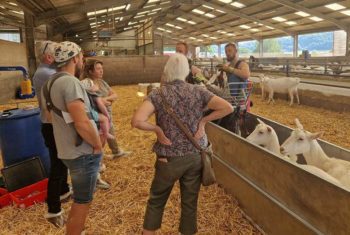17 Jul 2023
David Harwood BVetMed, FRCVS reviews the Goat Veterinary Society’s annual congress, during which a new president was announced.

"With liver fluke, it is important when attempting to advise on control, to look at the farm as a whole, and score fields as to the level of risk depending on the availability of suitable mud snail habitats." Image: © Nataly / Adobe Stock
The Goat Veterinary Society (GVS) held its annual congress last month with delegates spending time at Cheltenham Racecourse, as well as a local dairy unit.
Along with a number of speakers, the event also hosted the annual meeting, which included a change of president.
On 14 June, attendees spent the first afternoon visiting a large commercial dairy goat unit nearby, kindly hosted by a GVS member. During the visit, delegates were split into groups rotating around four separate stations covering practical hoof trimming, kid rearing, practical nutrition as well as fertility and infertility.
The main part of the congress, the following day, was held at Cheltenham Racecourse’s conference centre and kicked off with the annual meeting, during which current president Nick Perkins stood down after five years in the role. He welcomed his successor, Ben Dustan, who moved from his existing role as secretary to become the new GVS president, and new secretary Yasmine Cooper.
Before the congress got underway, the first recipient of the Nick Clayton Cup was announced – Nick was a long-standing secretary and committee member of GVS who passed away in 2022. The cup was awarded to Kate Hovers for her 2022 presentation and paper entitled “Management changes to reduce parasite dosing in meat goats”. Fittingly, the presentation was made by Nick’s son and daughter, Huw Clayton and Heather Arnold.
The first speaker was Sam Kelly, of Kelly Consulting, who gave an update on the dairy goat sector finances after a particularly volatile time period since his last presentation to the society. On-farm decisions can have a local impact, such as the method of feeding employed.
Feeding a total mixed ration, or TMR, will lessen the impact of world feed prices, but necessitates a higher machine cost. Conversely, relying on ad lib concentrates has the opposite impact.
Although the speaker stated that overall farm costs – feed, fertiliser, fuel and electricity – have eased back in the past six months, they are still significantly higher than two years ago. Added to this is the fact that wholesale milk prices have not kept pace with these cost increases.
Labour costs have also increased as the National Living Wage has increased by 9.7% and employer National Insurance from 13.8% to 15.05%. It is also increasingly difficult to find good farm staff; typically many have to pay 20% more than two years ago to attract good staff. Goat milk price simply isn’t keeping pace with the cost of production, partly due to basic supply and demand, resistance from retailers and customers on higher priced product, and competition from other alternatives. The speaker did feel that huge potential exists in the world export market for UK dairy goat products and these need to be explored.
The next speaker was Arthur Otter, of APHA Shrewsbury.
Clostridial organisms are anaerobic, heat resistant bacilli that cause disease, predominantly via toxin production. Many species of the genus exist, causing a spectrum of diseases in both animals and man. The most significant pathogen in goats is Clostridium perfringens type D, caused by overgrowth of the organism in the gut, resulting in excess toxin production and overwhelming enterotoxaemia. This same organism causes pulpy kidney in sheep, and is a commensal at low levels in the majority of goats and sheep. All ages of goat are susceptible. The main clinical sign is diarrhoea, which is yellow-green liquid to mucoid or even haemorrhagic. It can be rapidly fatal in some, others may survive for a few days.

A chronic form has also been identified causing intermittent diarrhoea and weight loss, which may improve after vaccination. The disease is unpredictable, but may follow sudden diet change. Confirmation of disease is via the clinical signs and demonstration of toxin in small intestinal content.
The speaker then went on to describe the spectrum of diseases seen in other species, with only tetanus a diagnosis occasionally made in goats. Tetanus results in spastic paralysis leading to progressive stiffness, difficulty standing, recumbency and the typical extensor rigidity. Key to preventing these diseases is vaccination. The GVS recommends the use of Lambivac as first choice vaccine, boosting every six months. Vaccine availability, however, is currently a key problem.
Arthur Otter gave a second paper, considering key notifiable diseases in the UK and their differential diagnoses. Bluetongue is primarily a disease of sheep and cattle, but cases have been identified in goats. It is caused by an arbovirus, of which 29 differing serotypes all spread between infected animals by insect vectors, particularly Culicoides midges. Its only incursion into the UK was in 2007, and the UK has been officially free since 2011.
Perhaps the most important notifiable disease for us in the UK is foot-and-mouth disease, probably the most infectious disease known, which, as the experiences of 2001 show, can spread rapidly with devastating consequences. The incubation period is from 24 hours to 10 days, but averages three to six days – and lesions can be aged to aid an epidemiological assessment. The most important differential diagnosis is orf for mouth lesions, and scald or foot rot for foot lesions.
The speaker then described some of the key notifiable diseases being dealt with in other countries, including peste des petits ruminants, which was first seen in Europe (Bulgaria) in 2018. Brucella melitensis and Brucella ovis have never been seen in the UK, but can cause abortion, and infertility and contagious epididymytis, respectively.
Matt Colston, of Elanco, then took delegates through the important topic of goat parasites. He reminded the audience that goats have evolved as browsing animals, and this seems to have had an influence on their ability to develop age-dependent resistance to worms seen in cattle and sheep. He described goats as “worm multipliers”, rapidly contaminating the cleanest of pastures if infected and uncontrolled.
Whereas worms have a direct life cycle, liver fluke has a life cycle aided and abetted by a mud snail. With liver fluke, it is important, when attempting to advise on control, to look at the farm as a whole, and score fields as to the level of risk depending on the availability of suitable mud snail habitats.

Fluke diagnosis can be made via faecal examination (egg counts and coproantigen testing), postmortem examination and slaughterhouse returns. The fluke antibody test is not validated for use in goats. Diagnosis of worm problems again rely on regular faecal egg counts, postmortem examination and assessments of treatment efficacy.
Regarding treatment for worms, only eprinomectin has a marketing authorisation for use in goats, but “off label” use of other anthelmintics at increased dose rates is always an option. The speaker advised against using closantel in goats due to potential toxicity, and to avoid the use of the albendazole group in early pregnancy due to potential embryo damage.
Peers Davies, of the University of Liverpool, discussed Mycobacterium avium subspecies paratuberculosis (MAP), an intracellular obligate pathogen that can survive in the environment, but that needs a host to replicate. It causes disease essentially by gut damage and thickening causing malabsorption and is often classified as an “iceberg” disease with a small “tip” of clinical cases, but a much higher number of sub-clinical or pre-clinical cases.
The ELISA test on blood samples is useful when clinical disease is evident, but it is far too insensitive to be used as a screening test. The PCR test is much more sensitive, but has produced very variable results between laboratories given the same faecal samples for comparison in a recent study.
Obvious losses include increases on farm mortality, reduced milk yields and eventual cull value.
Insidious losses described in sheep flocks include reduced fertility, reduced fecundity and premature culling. Options for control include vaccination to reduce shedding and artificial rearing to avoid exposure.
Continuing with the Johne’s theme was Bryony Kendall, of Tyndale Vets, who gave the audience an update on a Johne’s control plan being developed jointly by the GVS, British Goat Society and Milking Goats Association. This has been developed predominantly as a result of a Red Tractor requirement for all dairy goat herds to join the National Johne’s Control Scheme, with many concerns raised over its relevance in its current format to goats. In phase one last year, a Johne’s disease fact sheet was developed alongside a drive to encourage herds to participate and gauge their own herd risk status.
Moving forward, the plan is to roll out a series of talks and training events to emphasise the importance of developing a control plan to keep it out, control and manage it, and eradicate where possible.
The next meeting of the GVS will be via virtual webinar in November.